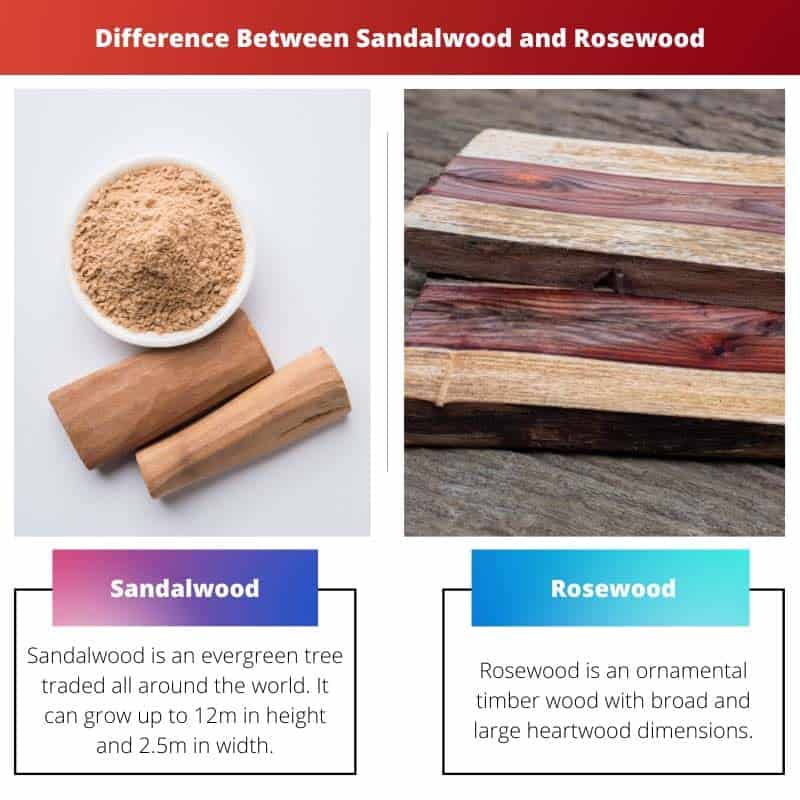Nature offers us a wide range of treasures to behold. Two of the wonders of nature include Sandalwood and Rosewood.
Sandalwood and Rosewood are majestic and delicate trees because of their unique characteristics, healing properties, and aromatic significance. They are exported all over the world and are highly esteemed for what they offer.
Key Takeaways
- Sandalwood has a distinct fragrance and retains its scent for a long time, whereas rosewood lacks a strong aroma.
- Sandalwood trees mature more slowly than rosewood trees, resulting in a higher price for sandalwood products.
- Sandalwood is primarily used for making incense, perfumes, and cosmetics, while rosewood is mainly used in furniture and musical instrument production.
Sandalwood vs Rosewood
Sandalwood is a class of woods from trees in the genus Santalum, valued for their distinctive fragrance, used in incense and perfumes. Rosewood refers to any of a number of richly hued timbers, brownish with darker veining, primarily used in furniture-making due to its strength and beauty.

Sandalwood is an evergreen tree traded all around the world. It can grow up to 12m in height and 2.5m in width.
It is mostly located in the islands of the South Pacific and southeastern Asia. Sandalwood trees have leathery leaves on the plants and are partially parasitic on the roots of opposite branches.
Rosewood is an ornamental timber wood with broad and large heartwood dimensions. The tree gains planks and squared logs at maturity, this implies that that wood has started to decay.
This is indicated by a hollow at the center which depicts a faulty rosewood. Rosewood is exported for its unique properties.
Comparison Table
| Parameters of Comparison | Sandalwood | Rosewood |
|---|---|---|
| Other names | Santal oil, Saunders oil, Santalum | Dalbergia stevensoni, Bahia, Acacia excelsa |
| Uses | Vital for medicinal uses, antiseptic properties, and skin healing properties. | Popular in furniture making, known for luxurious goods such as guitars. |
| Aroma | The smell is earthy, woody, and also be considered rich and creamy. | It has a sweet and strong smell. |
| Largest Producers/Suppliers | Australia has become the largest producer of sandalwood. | China is one of the biggest exporters and suppliers of Rosewood. |
| Colors | Sandalwood is available in colors such as Red, White, Yellow, and brown. | The color range of rosewood includes orange, black bars, deep purple, yellow and red. |
What is Sandalwood?
Sandalwood derives its name from the genus Santalum. Sandalwood is one of the most cherished heritages in the world.
It is one of the most expensive trees present in the world and is known for its valuable products which include wood and its oil. Sandalwood derives its name from the Sanskrit term Chandanam meaning ‘Wood for burning license’.
The primary characteristics of the sandalwood include heavy trees, fine-grained, yellow-toned trees with the ability to sustain them for a long time. Sandalwood oil extracted from the tree is known for its aromatic and ayurvedic properties.
Sandalwood has been in the market for over 1000 years. There are over 25 different species of sandalwood found across the parts of Oceania, Ecozones, Indomalaya, and Australia.
The heritage of Sandalwood dates back to Asia due to its diverse therapeutic and aromatic values. The sandalwood market was primarily dominated by India with over 85% of the produce coming from Kerala and Karnataka.
Some of the popular types of sandalwood include Santalum Haleakala, Indian Sandalwood, Australian Sandalwood, and Santalum acuminatum. Some of the species of Sandalwood are highly prone to extinction due to the overuse of resources, exploitation of trees, and overconsumption of sandalwood products.

What is Rosewood?
Rosewood is a rich timber wood that belongs to the genus Dalbergia. It is commonly and popularly referred to as Dalbergia Nigra.
Rosewood is known for its shiny, smooth, and glossy texture with hints of coarse grains all across the tree.
It produces a crisp sound on the wood on knocking without any noises. It is easy to distinguish fake rosewood products from real products.
The fake products may get the tint of the hues of rosewood, but it is impossible to produce the texture of the real wood.
The prominent types of Rosewood include Dalbergia, Dalbergia melanoxyl, Maritima, Cocobolo, and Bariensis. Rosewood is primarily grown in the places of Honduras, Jamaica, Africa, India, and Brazil.
It has a resinous texture making it difficult to work with. It is a dense wood tree, known for its uses in the construction and development of decoration items.
It also has medicinal properties. The rosewood essential oil is a great component for antiseptic, antidepressant, aphrodisiac, and analgesic properties.
It is a powerful remedy for a wide range of therapeutic needs such as relieving pain, tired skin, wrinkles, acne and provides a glow to the skin. The rosewood essential oil is also a great application to heal skin internally.

Main Differences Between Sandalwood and Rosewood
- Sandalwood has an incredible aroma and it does not easily wear out. The smell and texture may change over time. Rosewood has a lasting smell and can last for many years efficiently.
- The restrictions on the trade on sandalwood are reduced in recent years than the trade of rosewood in the world. Due to illegal trading and the over-exploitation of the rosewood trees, it has been heavily restricted.
- Sandalwood can live up to a hundred years of age. Rosewood can live up to the age of 60 years, it reaches maturity at the age of 19 to 21 years.
- Sandalwood is consumed globally, while rosewood is highly consumed and supplied in China with vast demand increase in the past 10 years.
- Sandalwood tree is grown in dry deciduous forests. The rosewood, on the other hand, is grown in Tropical evergreen forests.

- https://www.cabdirect.org/cabdirect/abstract/19990603455
- https://www.sciencedirect.com/science/article/pii/S1018364720300082
